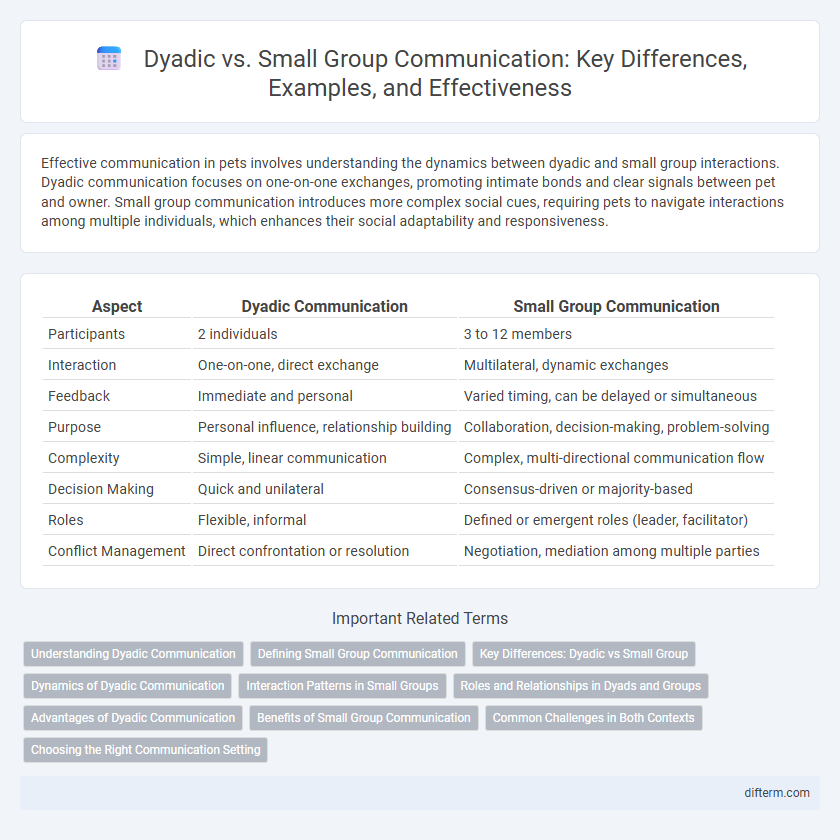Effective communication in pets involves understanding the dynamics between dyadic and small group interactions. Dyadic communication focuses on one-on-one exchanges, promoting intimate bonds and clear signals between pet and owner. Small group communication introduces more complex social cues, requiring pets to navigate interactions among multiple individuals, which enhances their social adaptability and responsiveness.
Table of Comparison
| Aspect | Dyadic Communication | Small Group Communication |
|---|---|---|
| Participants | 2 individuals | 3 to 12 members |
| Interaction | One-on-one, direct exchange | Multilateral, dynamic exchanges |
| Feedback | Immediate and personal | Varied timing, can be delayed or simultaneous |
| Purpose | Personal influence, relationship building | Collaboration, decision-making, problem-solving |
| Complexity | Simple, linear communication | Complex, multi-directional communication flow |
| Decision Making | Quick and unilateral | Consensus-driven or majority-based |
| Roles | Flexible, informal | Defined or emergent roles (leader, facilitator) |
| Conflict Management | Direct confrontation or resolution | Negotiation, mediation among multiple parties |
Understanding Dyadic Communication
Dyadic communication involves two individuals engaging in direct, face-to-face interaction, allowing for immediate feedback and personalized exchanges. This form of communication enhances mutual understanding through nonverbal cues like body language, facial expressions, and tone of voice, which are often diluted in small group settings. Unlike small group communication, where multiple perspectives and potential for misinterpretation increase, dyadic communication fosters clarity and deeper relational connections.
Defining Small Group Communication
Small group communication involves interactions among three to twelve participants who share common goals and engage in collaborative decision-making processes. Unlike dyadic communication, which focuses on one-on-one exchanges, small group communication emphasizes the dynamics of multiple viewpoints, roles, and interpersonal relationships that influence group cohesion and productivity. Key components include verbal and nonverbal messages, feedback loops, and the establishment of group norms that facilitate effective collaboration.
Key Differences: Dyadic vs Small Group
Dyadic communication involves two participants engaging in direct, personalized interaction, enhancing intimacy and immediate feedback. Small group communication includes three to twelve members, fostering diverse perspectives but requiring coordination to manage roles and conflicts effectively. The key differences lie in interaction complexity, communication flow, and group dynamics, impacting message clarity and decision-making processes.
Dynamics of Dyadic Communication
Dyadic communication involves direct, face-to-face interaction between two individuals, allowing for immediate feedback and personalized exchanges that enhance understanding and emotional connection. The dynamics in dyadic communication emphasize active listening, nonverbal cues, and responsiveness, which foster deeper trust and rapport compared to small group settings. In contrast, small group communication introduces multiple perspectives but may dilute individual participation and slow down the feedback process.
Interaction Patterns in Small Groups
Interaction patterns in small groups exhibit greater complexity compared to dyadic communication, involving multiple simultaneous exchanges that create dynamic feedback loops. Small groups often engage in turn-taking, overlapping dialogues, and role negotiation, enhancing collaborative problem-solving and decision-making processes. These multifaceted interaction patterns foster diverse perspectives and collective creativity, distinguishing small group communication from the typically linear nature of dyadic exchanges.
Roles and Relationships in Dyads and Groups
Roles in dyadic communication are typically more fluid, with participants often exchanging functions such as speaker and listener, fostering direct and personal relationships. In small groups, distinct roles tend to emerge, including leaders, facilitators, and note-takers, which establish a structured interaction dynamic that supports task achievement and social bonding. Relationships in dyads are generally more intimate and emotionally connected, while group relationships rely on interdependence and collective identity to maintain cohesion and effectiveness.
Advantages of Dyadic Communication
Dyadic communication enables personalized and focused interaction, fostering deeper understanding and immediate feedback between two individuals. This one-on-one exchange enhances trust and rapport, making it ideal for resolving conflicts or discussing sensitive topics. The simplicity of dyadic communication reduces misunderstandings and allows for efficient decision-making compared to small group settings.
Benefits of Small Group Communication
Small group communication enhances collaboration by enabling diverse perspectives and fostering creativity, leading to more comprehensive problem-solving than dyadic interaction. The dynamic exchange within groups improves decision quality through collective input and shared responsibility. Increased social support and interpersonal learning in small groups promote higher engagement and motivation among members.
Common Challenges in Both Contexts
Both dyadic and small group communication face common challenges such as misinterpretation of messages, lack of active listening, and emotional barriers that hinder clear understanding. In both contexts, differences in communication styles, cultural backgrounds, and power dynamics often lead to conflicts and reduced collaboration. Effective feedback mechanisms and establishing trust are essential to overcoming these obstacles and enhancing message clarity.
Choosing the Right Communication Setting
Selecting the appropriate communication setting depends on the interaction's purpose, with dyadic communication ideal for personal, focused exchanges between two individuals. Small group communication suits collaborative tasks requiring diverse perspectives and shared decision-making among three to twelve participants. Understanding the dynamics, goals, and participant needs helps optimize message clarity and engagement in either dyadic or small group settings.
dyadic vs small group Infographic

 difterm.com
difterm.com